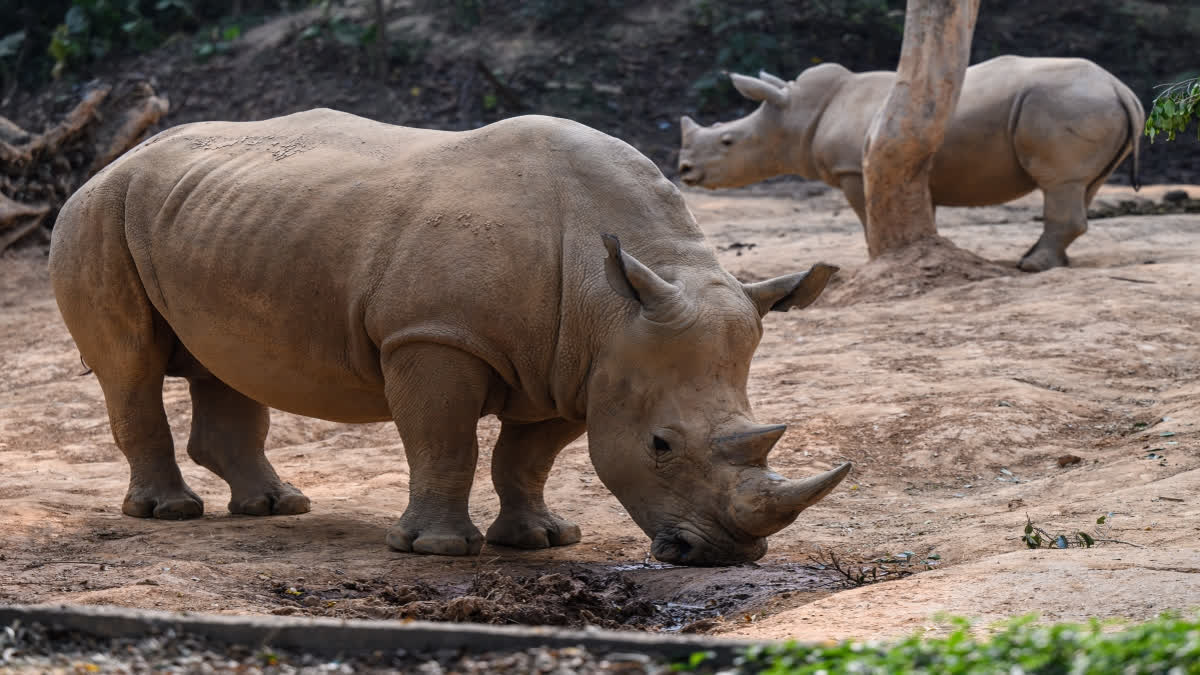Hyderabad:World Rhino Day is a day of awareness for all five rhino species and the work being done to save them. Since 2011, World Rhino Day has been celebrated internationally on September 22nd by rhino experts and advocates around the world. On World Rhino Day, the International Rhino Foundation celebrates the five species of rhinos and all those who care about them.
It all started with an email
World Rhino Day was first announced by WWF (World Wide Fund for Nature)-South Africa in 2010. The following year, World Rhino Day grew into an international success, encompassing both African and Asian rhino species. In 2011, a woman called Lisa Jane Campbell wrote a mail to a rhino lover, Rhishja expressing her interest to see at least five species of rhinos alive in the world. This is how World Rhino Day came into existence and people celebrate it every year across the nations on the same date.
The Rhino Family
Sumatran rhinos: Sumatran rhinos are the smallest of the living rhinoceroses and the only Asian rhino with two horns. The Sumatran rhino once roamed as far away as the foothills of the Eastern Himalayas in Bhutan and eastern India, through Myanmar, Thailand, possibly to Vietnam and China, and south through the Malay Peninsula. Today, the species only survives on the Indonesian islands of Sumatra and Borneo.
Black rhinos: Among black and white rhinos, black rhinos are the smaller of the two African rhino species. Black and white rhinos can be distinguished by the shape of their lips. Black rhinos have hooked upper lips, whereas white rhinos are characterised by a square lip. The population of black rhinos declined dramatically in the 20th century at the hands of European hunters and settlers. Thanks to persistent conservation efforts across Africa, black rhino numbers have doubled from their historic low 20 years ago to more than 6,000 today.
White rhinos: White rhinos are the second-largest land mammal and their name comes from the Afrikaan’s, a West Germanic language, word “weit” which means wide and refers to the animal’s mouth. Also known as the square-lipped rhinoceros, white rhinos have a square upper lip with almost no hair. The majority of the southern white rhinos occur in just four countries: South Africa, Namibia, Zimbabwe, and Kenya. Southern white rhinos were thought to be extinct in the late 19th century, but in 1895 a small population of fewer than 100 individuals was discovered in Kwazulu-Natal, South Africa.
Javan rhinos:Javan rhinos are the most threatened of the five rhino species, with only around 76 individuals that live only in Ujung Kulon National Park in Java, Indonesia. Javan rhinos once lived throughout northeast India and Southeast Asia. Vietnam’s last Javan rhino was poached in 2010.
The greater one-horned rhino: The greater one-horned rhino (or 'Indian rhino') is the largest of the rhino species. Once widespread across the entire northern part of the Indian sub-continent, rhino populations plummeted as they were hunted for sport or killed as agricultural pests. The recovery of the greater one-horned rhino is among the greatest conservation success stories in Asia. Thanks to strict protection and management from Indian and Nepalese wildlife authorities, the greater one-horned rhino was brought back from the brink. Today populations have increased to around 4000 rhinos in northeastern India and the Terai grasslands of Nepal.
State of the Rhino: 2024 Report
Every September, the International Rhino Foundation (IRF) publishes our signature report, State of the Rhino, which documents current population estimates and trends, where available, as well as key challenges and conservation developments for the five surviving rhino species in Africa and Asia.
Highlights of the 2024 State of the Rhino Report
With all five species combined, there are just under 28,000 rhinos left in the world.
Rhino poaching in Africa increased by 4% from 2022 to 2023. At least 586 African rhinos were poached in 2023, one every 15 hours.
